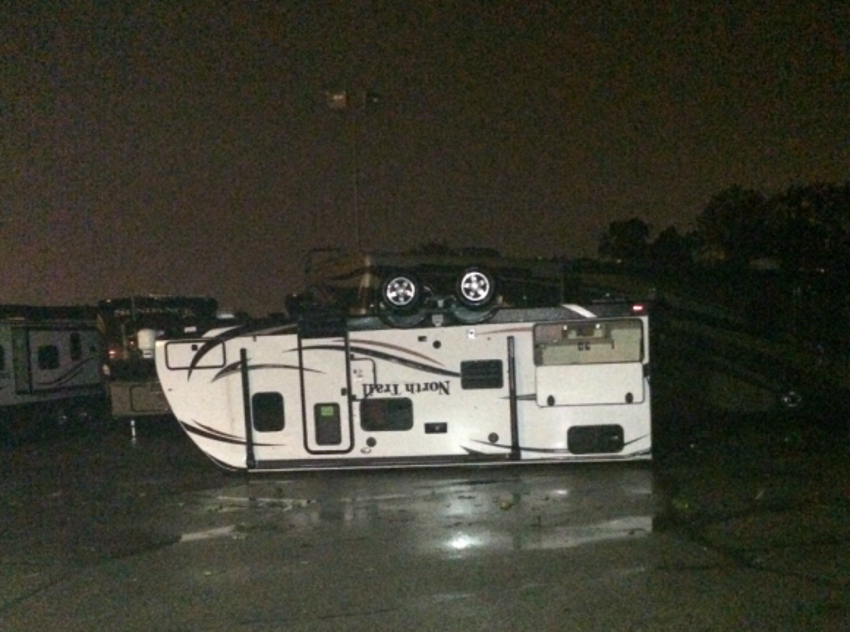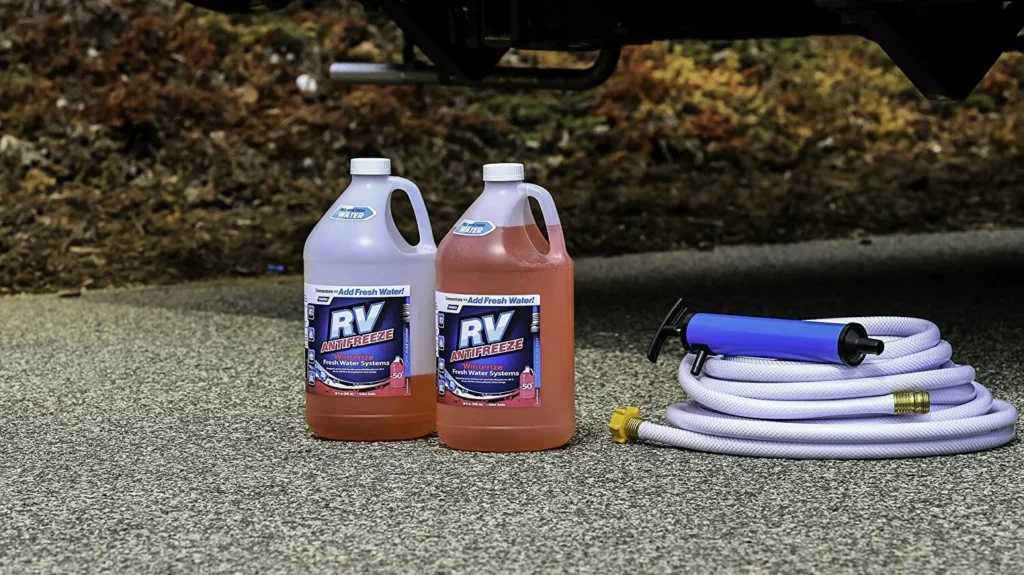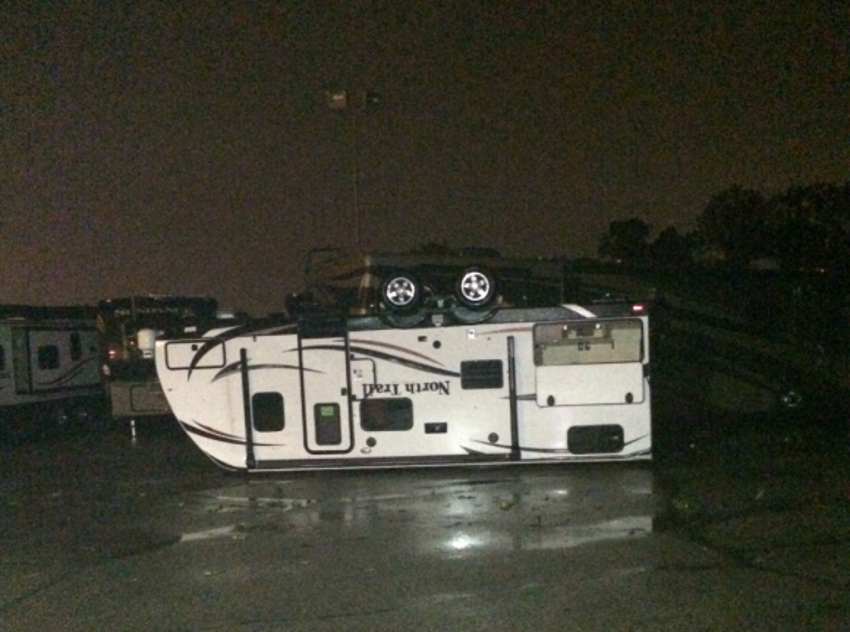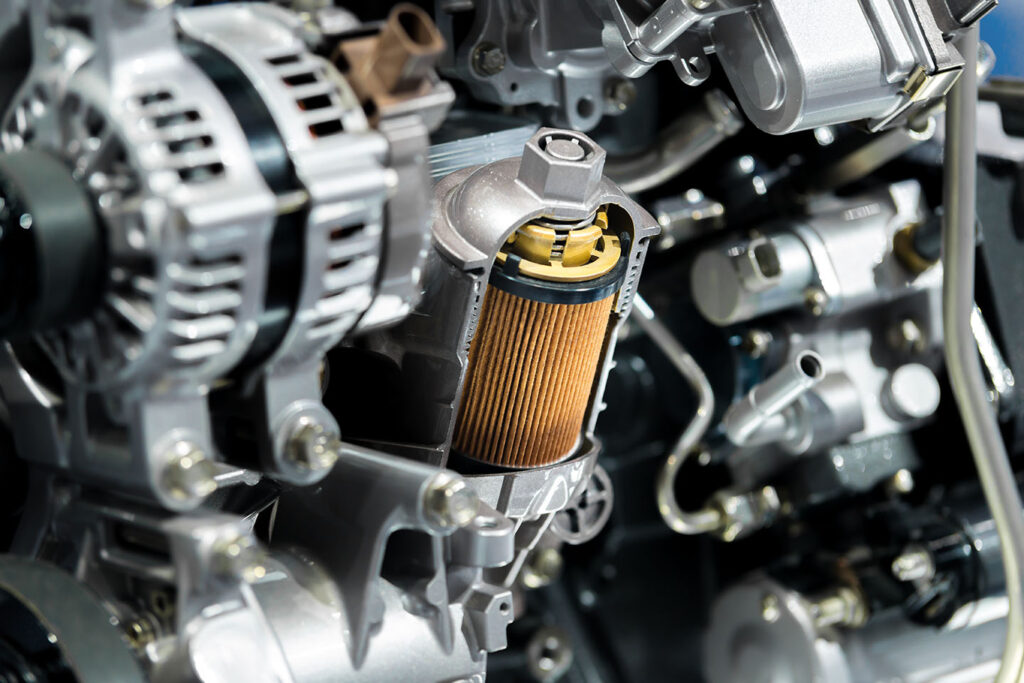Sanitizing your RV fresh water tank is essential. Bleach is common, but not ideal.
Keeping your RV’s fresh water tank clean ensures safe drinking water. Many prefer to avoid bleach due to its strong odor and potential health concerns. Luckily, there are effective alternatives. In this guide, we’ll explore how to sanitize your RV fresh water tank without using bleach.
You’ll learn safe, natural methods that keep your water fresh and clean. Say goodbye to bleach and hello to a healthier way of maintaining your RV’s water system. This approach will help you enjoy your travels with peace of mind. Ready to dive in? Let’s get started!

Credit: www.pinterest.com
Table of Contents
Importance Of Sanitizing Rv Fresh Water Tank
Sanitizing your RV’s fresh water tank ensures clean, safe drinking water. Bleach-free methods can be effective and eco-friendly. Regular cleaning prevents bacteria build-up, protecting your health.
Sanitizing your RV fresh water tank is crucial. It ensures your water stays clean and safe. Drinking or using dirty water can cause health issues. You don’t want to risk that. Regular cleaning helps maintain water quality.Health Benefits
Clean water is vital for good health. It prevents stomach problems. You avoid bacteria and viruses that make you sick. Safe water means peace of mind. Your trips stay enjoyable and stress-free.Preventing Contamination
Contaminated water can ruin your trip. It can cause unpleasant odors and taste. Bacteria and mold grow in dirty tanks. These can spread and cause infections. Regular sanitizing stops this. It keeps your tank free from harmful germs. “`Common Issues With Bleach
Using bleach to sanitize your RV fresh water tank may seem effective. But it often comes with several common issues. Bleach can leave behind harmful chemical residue and negatively impact the environment. Explore these issues further with the following points.
Chemical Residue
Bleach can leave behind chemical residue in your RV water tank. This residue can affect the taste and smell of your water. It can also be harmful if ingested. Even thorough rinsing may not remove all traces of bleach.
Residue from bleach can also affect the tank materials. Over time, it can cause wear and tear. This can lead to leaks and other damages. Using bleach may result in costly repairs.
Environmental Impact
Bleach has a significant environmental impact. It is a harsh chemical that can harm aquatic life. When you rinse your tank, the bleach can end up in the water system. This contributes to water pollution.
Using bleach also contributes to chemical waste. Manufacturing bleach releases pollutants into the air. Choosing alternatives to bleach helps reduce your environmental footprint.
Alternative Sanitizing Methods
Sanitize your RV fresh water tank without bleach using vinegar or hydrogen peroxide. These alternatives effectively kill bacteria and ensure safe drinking water. Regular cleaning with these methods keeps your water tank fresh and clean.
Sanitizing your RV fresh water tank is crucial for maintaining clean water on your adventures. If you’re looking to skip the bleach for a more eco-friendly approach, there are effective alternative sanitizing methods. In this section, we’ll explore some natural solutions and commercial products that can help you keep your water tank fresh and safe. ### Natural Solutions Using natural solutions to sanitize your RV fresh water tank is not only eco-friendly but also safer for your health. One effective method is using vinegar. Fill your tank with a solution of vinegar and water, using about a quart of vinegar for every fifteen gallons of water. Allow it to sit for several hours, then drain and rinse the tank thoroughly. Baking soda is another natural solution. Mix baking soda with water to create a paste and scrub the inside of the tank. This method can help eliminate odors and bacteria. Hydrogen peroxide is also a fantastic option. Use a 3% hydrogen peroxide solution, mixing one cup for every fifteen gallons of water. Let it sit for a few hours, then rinse well. Natural sanitizing methods are not only effective but also gentle on your RV’s plumbing system. Ever tried any of these? They are surprisingly easy and effective! ### Commercial Products If you prefer ready-to-use solutions, several commercial products are designed to sanitize RV fresh water tanks without bleach. These products are convenient and often more powerful than natural solutions. Camco TastePURE is a popular option. It uses a blend of non-toxic chemicals that effectively clean and sanitize the tank. Simply follow the instructions on the label, and you’re good to go. Another excellent product is Star Brite Aqua Water Treatment. It’s known for its powerful sanitizing properties while being safe for your tank. Thetford Fresh Water Tank Sanitizer is also highly recommended. It’s specifically formulated for RV water systems and does not leave any aftertaste or odor. These commercial products offer a hassle-free way to ensure your water tank is clean. Have you tried any commercial sanitizers? They can save you time and effort. Switching to alternative sanitizing methods can be a game-changer for your RV maintenance routine. Have you considered trying these methods? They might be the perfect solution for your next trip.Using Vinegar
Clean your RV fresh water tank using vinegar for a natural and effective solution. Mix vinegar with water, fill the tank, and let it sit for a few hours before rinsing. This method avoids harsh chemicals and keeps your tank safe.
When it comes to maintaining your RV’s fresh water tank, using bleach can be a bit too harsh for some. Luckily, vinegar offers a natural and effective alternative. I’ve personally found it to be a reliable solution for keeping my tank clean and safe. Let’s dive into how you can make the most out of vinegar for sanitizing your RV’s fresh water tank.Effectiveness
Vinegar is a powerful yet gentle cleaning agent. It’s naturally acidic, which makes it excellent at breaking down mineral deposits and bacteria. When I switched to using vinegar, I was pleasantly surprised at how well it worked. Not only did it leave my water tasting fresh, but I also felt good knowing I was using a natural product. Have you ever wondered if natural cleaners can be as effective as chemical ones? Vinegar proves that they can. It’s been used for generations to clean everything from kitchen counters to fresh water tanks. Plus, it’s readily available and affordable.Step-by-step Guide
Here’s a simple step-by-step guide to sanitize your RV fresh water tank using vinegar: 1. Drain the Tank: Start by completely draining the fresh water tank. This ensures that you’re working with a clean slate. 2. Prepare the Solution: Mix one gallon of white vinegar with four gallons of water. This ratio works well to provide a thorough clean without being too concentrated. 3. Fill the Tank: Pour the vinegar solution into the fresh water tank. If your tank is large, you might need to prepare more solution. 4. Run the Water: Turn on the pump and run the water through all your faucets. Make sure the solution reaches every part of the system. This might take a few minutes, so be patient. 5. Let it Sit: Allow the solution to sit in the tank for at least 12 hours. This waiting period is crucial as it gives the vinegar time to break down any buildup. 6. Flush the System: After the solution has done its job, drain the tank again. Then, refill it with fresh water and run the water through all faucets until you no longer smell vinegar. This step ensures all the vinegar is flushed out. 7. Check and Repeat if Necessary: Finally, check the water quality. If you still notice any odd tastes or odors, you might need to repeat the process. Using vinegar is a straightforward and eco-friendly way to maintain your RV’s fresh water tank. Have you ever tried using vinegar for cleaning? If not, now might be the perfect time to give it a go. You’ll likely find it as effective and satisfying as I did. Remember, keeping your RV’s fresh water tank clean is essential for your health and overall travel experience. Why not try vinegar the next time your tank needs a good clean?Hydrogen Peroxide
Hydrogen peroxide is an effective alternative to bleach for sanitizing your RV fresh water tank. This common household item is known for its antibacterial properties. Using hydrogen peroxide can help ensure safe drinking water without the harshness of bleach.
Advantages
Hydrogen peroxide is non-toxic. It breaks down into water and oxygen, leaving no residue. It is safe for the environment and for your water tank. It also helps eliminate odors. This makes it a preferred choice for those sensitive to strong chemicals.
Application Process
First, empty your water tank. Make sure to drain all the existing water. Then, mix hydrogen peroxide with water. Use about one cup of hydrogen peroxide for every 10 gallons of water. Pour the mixture into the tank. Fill the tank with fresh water. This helps distribute the hydrogen peroxide evenly.
Next, let the solution sit. Allow it to remain in the tank for at least 4 hours. This waiting period ensures that bacteria and other contaminants are killed. After the wait, drain the tank completely. Finally, rinse the tank with fresh water. This removes any remaining hydrogen peroxide.
Baking Soda And Lemon
Sanitizing your RV fresh water tank without bleach is possible. One effective and natural method involves using baking soda and lemon. This combination leverages the natural cleaning and deodorizing properties of both ingredients. It ensures your tank stays clean and safe for use.
Combination Benefits
Baking soda is known for its cleaning abilities. It helps remove stains and neutralizes odors. Lemon is a natural disinfectant. It has antibacterial and antiviral properties. Together, they create a powerful cleaning solution. This method is also environmentally friendly. It avoids the harsh chemicals found in bleach.
Cleaning Instructions
First, empty your RV fresh water tank. Ensure it is completely drained. Then, prepare your cleaning solution. Mix one cup of baking soda with two cups of lemon juice. Stir until the baking soda is fully dissolved. Pour this mixture into the empty tank.
Fill the tank with fresh water. Let the solution sit for several hours. This allows the baking soda and lemon to work effectively. Afterward, drain the tank completely. Rinse it thoroughly with fresh water. Repeat the rinsing process until no residue remains.
This method keeps your water tank clean and fresh. It also leaves a pleasant lemon scent. Regular cleaning with baking soda and lemon helps maintain the tank. It ensures safe and clean water for your travels.
Regular Maintenance Tips
Keeping your RV fresh water tank sanitized without bleach is crucial. Regular maintenance helps ensure clean, safe water. Following a consistent routine keeps your tank in top condition.
Scheduled Cleaning
Plan to clean your RV water tank every six months. Use a natural cleaner like vinegar. Combine one quart of vinegar with five gallons of water. Pour the mixture into the tank. Let it sit for 24 hours. Flush the tank with fresh water until the vinegar smell is gone. This method keeps the tank clean and fresh.
Routine Checks
Check the tank’s water quality monthly. Look for any signs of contamination. Use a water testing kit to ensure safety. Inspect the tank for any cracks or leaks. Fix issues immediately to prevent bigger problems. Regular checks help maintain water purity.

Credit: in.pinterest.com
Safety Precautions
Sanitizing an RV fresh water tank without bleach is easy and effective. Use vinegar, baking soda, or hydrogen peroxide for a safe and eco-friendly clean. Rinse thoroughly to ensure all residues are removed.
Sanitizing your RV fresh water tank without bleach involves using natural cleaners. These cleaners are safe but still require careful handling. Following safety precautions ensures the effectiveness of the process and keeps everyone safe.Handling Natural Cleaners
When using natural cleaners, wear gloves. This protects your skin from irritation. Vinegar and baking soda are common choices. Both are safe but can cause mild skin reactions. Keep these cleaners away from your eyes. If they come in contact with your eyes, rinse thoroughly with water. Store them in a cool, dry place. Ensure they are out of reach of children and pets.Avoiding Contamination
Use clean tools to avoid contamination. Clean all hoses and containers before use. This prevents introducing new bacteria into the tank. Do not use the same tools for other cleaning tasks. This avoids cross-contamination. Use fresh, clean water for rinsing. Ensure all parts are dry before refilling the tank. This helps maintain a safe water supply for your RV. “`Common Mistakes To Avoid
Ignoring proper drying can cause mold growth in your RV water tank. Neglecting to rinse thoroughly may leave residues. Using harsh chemicals can damage the tank.
Sanitizing your RV fresh water tank without bleach can be tricky. Many make mistakes that reduce effectiveness. Knowing these common errors helps you avoid them.Improper Cleaning Techniques
Many users do not clean the tank properly. Skipping steps leads to incomplete sanitization. Always follow a thorough process. Use the right materials. Avoid using harsh chemicals. They can damage the tank. Stick to natural cleaners. Vinegar and baking soda work well. Rinse the tank thoroughly. Any residue can cause problems.Ignoring Signs Of Contamination
Contamination signs are often ignored. Bad taste or smell is a clear sign. Cloudy water also indicates contamination. Regularly check for these signs. Ignoring them can lead to health issues. If you notice signs, sanitize the tank immediately. Do not wait. Keeping the tank clean ensures safe drinking water. “`
Credit: blog.campingworld.com
Frequently Asked Questions
How To Sanitize A Fresh Water Tank Without Bleach?
Use vinegar or hydrogen peroxide to sanitize your fresh water tank. Fill the tank with the solution, let it sit, then rinse thoroughly.
What Is The Best Way To Sanitize An Rv Water Tank?
To sanitize an RV water tank, use a mixture of bleach and water. Flush the system thoroughly. Repeat as needed.
How Much Vinegar Do I Need To Clean My Rv Fresh Water Tank?
Use 1 gallon of white vinegar per 15 gallons of water in your RV fresh water tank for cleaning.
How Do You Disinfect Water Without Bleach?
Boil water for at least one minute to disinfect. Use water purification tablets or UV light for effective results.
Conclusion
Sanitizing your RV fresh water tank without bleach is possible and safe. Vinegar and baking soda work effectively. They clean your tank without harsh chemicals. This method ensures your water stays fresh and drinkable. Regular maintenance is key. Always flush your tank after using cleaning agents.
Clean water is crucial for a pleasant RV experience. Keep your tank clean and enjoy your travels. Safe water makes every trip better. Stay proactive about cleanliness for a healthier journey.




